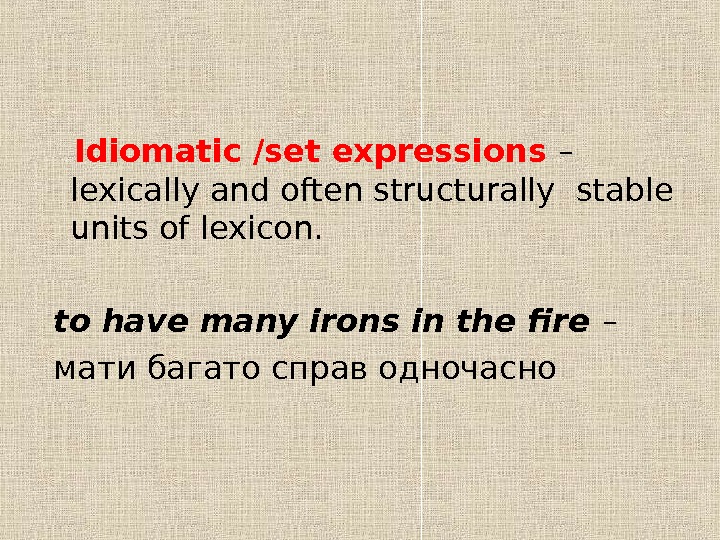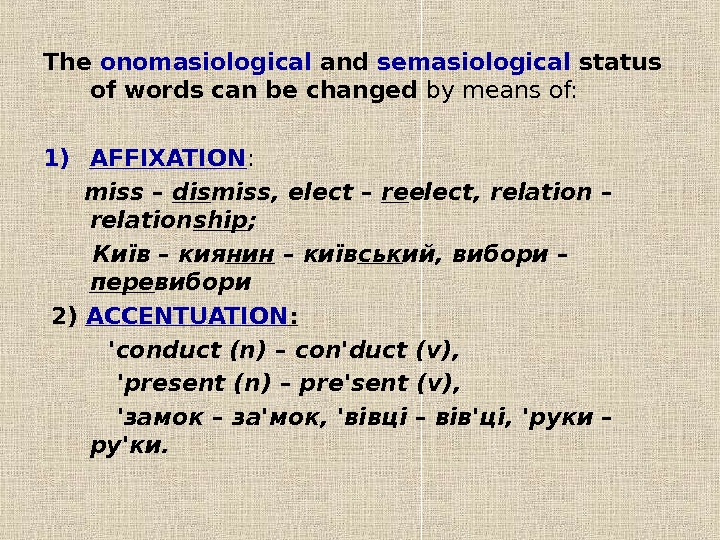TYPOLOGY OF LEXICAL SYSTEMS in ENGLISH and UKRAINIAN




























typology_of_lexical_systems.ppt
- Размер: 858.5 Кб
- Количество слайдов: 27
Описание презентации TYPOLOGY OF LEXICAL SYSTEMS in ENGLISH and UKRAINIAN по слайдам
 TYPOLOGY OF LEXICAL SYSTEMS in ENGLISH and UKRAINIAN
TYPOLOGY OF LEXICAL SYSTEMS in ENGLISH and UKRAINIAN
 The main constants of lexicon • Words • LSG • Idioms
The main constants of lexicon • Words • LSG • Idioms
 Word – the basic nominative unit of language with the help of which the naming function of language is realized.
Word – the basic nominative unit of language with the help of which the naming function of language is realized.
 Lexico-semantic groups – closely knit sectors of vocabulary, each characterised by a common concept : LSG formed by adjectives denoting ‘‘size’’: big, large, great, huge, enormous, small, little, tiny etc.
Lexico-semantic groups – closely knit sectors of vocabulary, each characterised by a common concept : LSG formed by adjectives denoting ‘‘size’’: big, large, great, huge, enormous, small, little, tiny etc.
 Idiomatic /set expressions – lexically and often structurally stable units of lexicon. to have many irons in the fire – мати багато справ одночасно
Idiomatic /set expressions – lexically and often structurally stable units of lexicon. to have many irons in the fire – мати багато справ одночасно
 Factors of Classifying Lexicon EXTRALINGUAL
Factors of Classifying Lexicon EXTRALINGUAL

 Physical and mental factors Due to the physical needs of human beings all languages have a number of common notions designated by words such as live, drink, eat, sleep, go, run, jump etc. Due to the common mental activity of people every language of the world comprises the notions designated by such words as think, speak, read, ask, answer, comprehend etc.
Physical and mental factors Due to the physical needs of human beings all languages have a number of common notions designated by words such as live, drink, eat, sleep, go, run, jump etc. Due to the common mental activity of people every language of the world comprises the notions designated by such words as think, speak, read, ask, answer, comprehend etc.
 Environmental factors All languages have common notions designated by the words reflecting objects and phenomena surrounding people: the sun, the moon, the stars, the sky, thunder, lightning, rain various species of living beings, plants, trees, colours etc.
Environmental factors All languages have common notions designated by the words reflecting objects and phenomena surrounding people: the sun, the moon, the stars, the sky, thunder, lightning, rain various species of living beings, plants, trees, colours etc.
 Social factor Involves different social phenomena as well as relationships and activities of a person. family level ( mother, father, sister, brother, aunt, cousin etc. ). other social activity of people ( a teacher, a student, a passenger, a shop-assistant etc. ).
Social factor Involves different social phenomena as well as relationships and activities of a person. family level ( mother, father, sister, brother, aunt, cousin etc. ). other social activity of people ( a teacher, a student, a passenger, a shop-assistant etc. ).
 Universal lexicon All words designating the notions which appear due to the extralingual principles constitute the UNIVERSAL lexicon of any language ( nucleus of the lexicon ).
Universal lexicon All words designating the notions which appear due to the extralingual principles constitute the UNIVERSAL lexicon of any language ( nucleus of the lexicon ).
 Dialectal, international and specifically national lexicons, coming to being under the influence of social, economic, historical and other extralingual factors, constitute the periphery of the lexicon.
Dialectal, international and specifically national lexicons, coming to being under the influence of social, economic, historical and other extralingual factors, constitute the periphery of the lexicon.



 English and Ukrainian lexicon (according to the stylistic principle) STYLE English Ukrainian High poetic heaven (sky) , to pass away (die) злото, л i та bookish wonderment ( здивування ) властолюбство archaic thee (you sing. ) , whereof (of which) гетьман , хорунжий Neutral face, life земля, вода, кв i тка Low colloquialisms bike(bycicle), gonna хапуга, вискочка slangisms governor ( батько ) , beans (brass, dibs, dough, off- грош i) хв i ст (академ. заборг. ) , шпора, шара, л i мони vulgarisms hell, shit чорт, прокляття
English and Ukrainian lexicon (according to the stylistic principle) STYLE English Ukrainian High poetic heaven (sky) , to pass away (die) злото, л i та bookish wonderment ( здивування ) властолюбство archaic thee (you sing. ) , whereof (of which) гетьман , хорунжий Neutral face, life земля, вода, кв i тка Low colloquialisms bike(bycicle), gonna хапуга, вискочка slangisms governor ( батько ) , beans (brass, dibs, dough, off- грош i) хв i ст (академ. заборг. ) , шпора, шара, л i мони vulgarisms hell, shit чорт, прокляття

 A word may be characterized from two sides: a) onomasiological side , i. e. from its structure and nomination capacity; b) semasiological or content side.
A word may be characterized from two sides: a) onomasiological side , i. e. from its structure and nomination capacity; b) semasiological or content side.
 Onomasiological investigation of the lexicon solves the problem how concepts (ideas) can be represented in the language. the structure of a language unit is studied with respect to its means of nomination : 1) inner 2) outer
Onomasiological investigation of the lexicon solves the problem how concepts (ideas) can be represented in the language. the structure of a language unit is studied with respect to its means of nomination : 1) inner 2) outer

 Words in both languages – the main means of nomination ( 75% In English and Ukrainian) Structurally they are : • simple words ( book, boy, new, ten, soon, книга, сам, там ) ; • derivative words ( teacher, friendship, книжечка, спатоньки ); • compounds ( blackboard, homework, перекотиполе, першочергово, лиходій , Незовибатько, Перервирядно, Крутивус, Задерихвіст, Товстоніг, Добридень, Панібудьласка ).
Words in both languages – the main means of nomination ( 75% In English and Ukrainian) Structurally they are : • simple words ( book, boy, new, ten, soon, книга, сам, там ) ; • derivative words ( teacher, friendship, книжечка, спатоньки ); • compounds ( blackboard, homework, перекотиполе, першочергово, лиходій , Незовибатько, Перервирядно, Крутивус, Задерихвіст, Товстоніг, Добридень, Панібудьласка ).
 Onomasiological characteristics displayed through morphological structure of the word and its categorial meaning : e. g. goes = go (root) + es (inflexion), the inflexion — es designates the categories of tense, mood, voice and person in the verb.
Onomasiological characteristics displayed through morphological structure of the word and its categorial meaning : e. g. goes = go (root) + es (inflexion), the inflexion — es designates the categories of tense, mood, voice and person in the verb.
 Borrowings in English 70 % in Ukrainian 10 %
Borrowings in English 70 % in Ukrainian 10 %
 Semasi о logy studies which ideas are represented in linguistic units, the semantic structure (scope of meaning) of words , expressions and texts under study. From the semasiological side words may be: 1) monosemantic 2) polysemantic.
Semasi о logy studies which ideas are represented in linguistic units, the semantic structure (scope of meaning) of words , expressions and texts under study. From the semasiological side words may be: 1) monosemantic 2) polysemantic.

 The onomasiolog і cal and semasiological status of words can be changed by means of: 1) AFFIXATION : miss – dis miss, elect – re elect, relation – relation ship ; Київ – кия нин – київ ськ ий, вибори – пере вибори 2) ACCENTUATION : ‘conduct (n) – con’duct (v), ‘present (n) – pre’sent (v), ‘ замок – за’мок, ‘вівці – вів’ці, ‘руки – ру’ки.
The onomasiolog і cal and semasiological status of words can be changed by means of: 1) AFFIXATION : miss – dis miss, elect – re elect, relation – relation ship ; Київ – кия нин – київ ськ ий, вибори – пере вибори 2) ACCENTUATION : ‘conduct (n) – con’duct (v), ‘present (n) – pre’sent (v), ‘ замок – за’мок, ‘вівці – вів’ці, ‘руки – ру’ки.
 TYPES OF MOTIVATION OF WORDS English Ukrainian 1) Phonetical 1. 08% 0. 8% 2) Morphological 88. 5% 91. 8% 3) Semantic 10% 7. 4%
TYPES OF MOTIVATION OF WORDS English Ukrainian 1) Phonetical 1. 08% 0. 8% 2) Morphological 88. 5% 91. 8% 3) Semantic 10% 7. 4%

